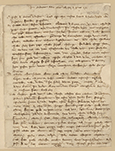THE DATINI's ARCHIVE: the Correspondence

In the 592 envelopes, there are about 150.00 letters, 125.000 of which are commercial papers (divided according to the eight Datini fondaci) and 25.000 form part of his private and family correspondence, specialised correspondence, private deeds and various documents and loose papers.

The term commercial or "common" correspondence stands to signify the correspondence between merchant companies of every sort, without any specialisation in content or form. The 125,000 letters were sent to the eight Datini fondaci from 267 towns in Italy and abroad.
For the most part, they were written in Vulgar Tuscan (and in other regional forms of Italian), but also in Latin, Catalan, Castilian, Provençal, Arabic and Hebrew.
For the most part, they were written in Vulgar Tuscan (and in other regional forms of Italian), but also in Latin, Catalan, Castilian, Provençal, Arabic and Hebrew.

Eight thousand letters are relevant to private and family correspondence (even though they, too, often offer precious elements of economic order), exchanged between Datini's immediate family and relations (rich is the correspondence with his wife, Margherita) and collaborators. Another 3,000 letters were sent by various people to different towns.
The specialised correspondence consists of about 10,000 pieces. Some of the many themes and dispositions of the "common correspondence" have given rise to particular letters with a specialisation of content. The following types emerge from the Datini collection:

- statements of account
- ricordanze (pledges)
- bills of exchange and other banking security
- clearing account orders
- orders for payment
- bank cheques
- way bills
- mandati di sicurtà (insurance mandates)
- strips and invoices
- valute di mercanzia (rates of merchandise)
- ships' cargoes
- permits.